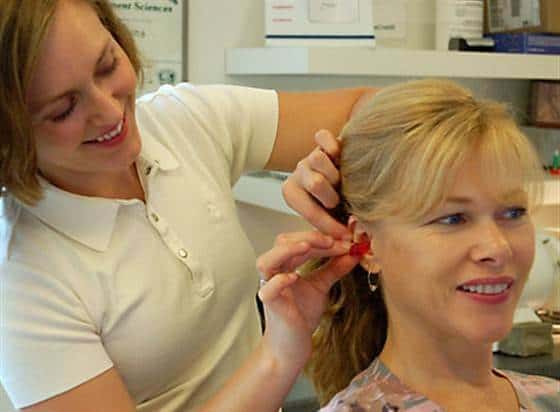You are happy and excited as you are meeting the audiologist for your first hearing aid fitting. You smile to yourself at the thought of the party tomorrow and once again you can socialize with family and friends without the fear of missing words and conversation. We don’t want to be a spoilsport but would like to caution you that if it’s your first time, then getting used to hearing aids will take a few days.
What To Expect When You Start Wearing Hearing Aids?
It is important to know that a hearing aid is a device that amplifies the sound to compensate for your deafness, it is not a cure for deafness. Initially, everything will sound strange, loud, and unbearable, the tonal quality of the sound will be different. But as you get used to the hearing aids, you will not notice the difference and will be more than happy with the benefits of using a hearing aid.
How Long Does It Take For Getting Used to Hearing Aids?
A new hearing aid user takes about a month or two for getting used to hearing aids. There is a little bit of patience and learning involved, your comfort level will increase with every passing day. Follow these tips to know how to get used to hearing aids.
1. Get Familiar with the Features of Your Hearing Aid
Your audiologist will brief you about the functions and features of your hearing aid. It is important to learn how to adjust hearing aids as features differ from one model to another.
The important feature to know is the multi-program settings. Digital hearing aids have multiple programs or settings to suit different environments or situations.
The most used programs are:
Speech in Quiet Program.
You have to select this program when you are at home or in the office, or in any environment that does not have too much background noise. the program can be changed by pressing the button on the hearing aid or a remote control or a phone app.
Speech in Noise Program.
You should select this program when you are outdoors surrounded by traffic and other noises. The hearing aid will cut out or reduce the background noise so you can hear speech better.
Hearing aid manufacturers offer multi-program options, you can discuss the setting of the other programs with your audiologist. Options like phone and restaurant settings are possible. For more information, read our article on 6 Must Have Hearing Aid Features.

2. How To Insert Hearing Aids Properly?
It is very important to know how to wear hearing aids. Learn how to insert hearing aids properly or you will hear a whistling sound known as audio feedback making it difficult to understand speech.
The method of inserting the hearing aids in the ear depends on the type of hearing aid. A different technique or hand movement is needed to insert a BTE earmold or a RIC dome compared to inserting an ITC or a CIC.
Learn the trick to insert hearing aids properly from your audiologist and practice a few times before leaving the clinic.
3. Start Using Your Hearing Aids in The House
The audiologist will program or tune the hearing aids according to your hearing loss. You feel good as you can hear the audiologist well and are not missing out on words. But a shock awaits you as you step out of the silent clinic into the noisy street. Everything seems too loud and intolerable that you feel like taking off your hearing aids.
Feel free to take them off and put them in the case. There is nothing wrong with your hearing aids, since you have hearing loss and have not heard loud sounds for some time, you are yet not ready for the noisy experience.
Start using the hearing aids in a silent environment as hearing aids amplify the surrounding sound. You and your brain need time for getting used to hearing aids and the new sounds.
Reach home, relax and wear your hearing aids again. You will notice a big difference between the sounds you heard on the street and the sound you hear now. This listening experience will be much more comfortable and closer to the one you experienced at the audiologist’s clinic.
4. Start Wearing Your Hearing Aids In a Quiet Room
If your house is on the main street and is exposed to external noise, move to the quietest room in the house. Initially, you need to explore and get familiar with the faint sounds you hear that you couldn’t hear earlier. The ticking of the clock, the hissing of the air conditioner, the closing of the door, and the doorbell ringing will sound strange, and at times very loud.
If you attend the office, then use your hearing aids after reaching your office, the traffic noise on your way to the office will make you uncomfortable and you may think of returning the hearing aids.
5. Does Wearing Hearing Aids Feel Strange?
Initially, it will feel strange, but do not worry, it’s a matter of getting used to the new hearing aids. You will not notice them as you slowly get accustomed to them and they will become a part of you. Do not discontinue using them, the benefits are more than the temporary discomfort.
6. Should I Wear My Hearing Aids All the Time?
Since you will be hearing a lot of loud sounds after a long time, it is possible that you may suffer from listening fatigue and in some cases sensory overload.
Hearing is one of the five senses, if any of the senses face a sudden increase of stimulus, in this case, hearing loud sounds, the brain, and the ears get overstimulated causing auditory sensory overload.
Auditory sensory overload causes tiredness, irritability, anxiety, and stress. Hence it is advisable to gradually increase the number of hours over days according to your comfort level.
7. How Many Hours A Day Should You Wear Hearing Aids?
It is advisable to take short breaks from hearing aids if the sounds are overwhelming and causing discomfort. Start your day with hearing aids, then take them off for some time. You can do that a few times a day and gradually increase usage once your auditory system gets used to the new hearing aids.
8. Why Does My Voice Sound Different?
Not recognizing your own voice is the biggest shock. Your hearing aid boosts frequencies that you couldn’t hear earlier, this changes the tonal quality making your voice sound different.
Secondly, when you speak, the vibrations of the voice box in your throat reach the ear through the cranium or your skull. It adds to the voice heard externally making your voice sound rich and pleasant. Hearing aid users hear more of the amplified sound through the hearing aid and less of bone conducted sound, hence the difference in your own voice.
Talk to yourself or read aloud to get familiar with your own voice. After practicing for a few days, your voice will not sound strange or different.
9. Why Does My Own Voice Echo?
Your ears are now plugged by the earmold, dome, or an in the ear hearing aid, depending on the type of hearing aid you are using. The plugged ear causes an occlusion effect. Some of the sound waves hit the wall of the ear canal or the ear drum and are reflected. These sound waves cannot escape since your ear is plugged causing an echo.
10. Am I Too Loud or Speaking Normally?
Due to your hearing loss, your voice was sounding very soft, with the new hearing aid, your voice is amplified. Take feedback from your family and friends on the ideal loudness level and adjust your speech accordingly.
11. Identify And Get Familiar with The Sounds Around You
Your brain has forgotten sounds like the hum of the air conditioner, the ringing of the doorbell, or the water running in the bathroom. Everything will sound very loud and unreal, close your eyes and identify the sounds around you. The human brain adapts very fast, you will be comfortable with the everyday background sounds around you in a matter of days.
Once you are comfortable with the sounds inside your house, try stepping out and identifying the sounds. The experience may be frustrating as the surrounding noise is high compared to the noise at home. Change the hearing aid program to the “speech in noise” setting as you step out. Your hearing aid will reduce the background noise level so you can hear speech better.
12. Start With a One-To-One Conversation
Initially, you will be uncomfortable discussing or conversing with a group of people. Sometimes it is difficult to identify the person talking or difficult to understand if more than one person is talking at a time. Practice conversing with one person, focus on the conversation and request them to repeat in case you miss a few words.
In case, you do not get the opportunity to have a one-to-one conversation often. An Audiobook is an excellent method for getting used to hearing aids, read the print version to identify the words you are unable to understand. Practice helps, the more you practice, the more comfortable you will feel with your hearing aids.
Start group conversations once you are comfortable with the one-to-one conversation. Initially, you will have difficulty but it’s a matter of patience and a positive approach. You should be happy that you are getting used to hearing aids and they are making a difference.
13. Watch Television with Your Hearing Aids On
Listening to television audio or dialogues is the toughest part. Users who are fully used to their hearing aids also have trouble understanding dialogues. Do not increase the volume of the TV set, it will make matters worse as the sound will distort and you may also inconvenience others in the room.
Watch movies and programs in the normal setting with subtitles or captions on, it will help you understand better.
Hearing aid manufacturers sell streaming and Bluetooth devices. These devices connect to the TV and stream or transmit audio wirelessly to your hearing aids. For more details, read our article on Bluetooth Hearing Aids & 9 Latest Features.

14. Do Not Change the Volume Setting Too Often
Many people start fiddling with the hearing aid volume if they cannot hear. It is important to know that increasing the hearing aid volume decreases clarity as it distorts the sound.
The lower the volume setting, the better the sound clarity. your audiologist has set the ideal volume as per your audiogram. Increasing the volume slightly will help in quiet surroundings but rarely helps in situations where the background noise levels are high.
15. Take A Follow Up Appointment with Your Audiologist
Getting used to new hearing aids is not easy. It is difficult to judge the sound quality, the wearing comfort, and new sounds in the silent environment of the clinic.
Wear the new hearing aids for a week or so and note down all the sounds that are too loud and the sounds you expected to hear but couldn’t.
Are the earmolds or the ITC/CIC hearing aid too tight and hurting? Or are they loose and keep falling out? Make a note and share your observations with your audiologist. Your audiologist can make proper adjustments to increase the comfort level and help you in getting used to hearing aids faster.
Getting used to hearing aids is challenging. The overwhelming experience of hearing too many sounds and the compromise between expectations and reality requires a positive attitude and determination.
Do not give up, the benefits of wearing hearing aids far outweigh the initial inconvenience. Contact your audiologist in case of any discomfort or query.
